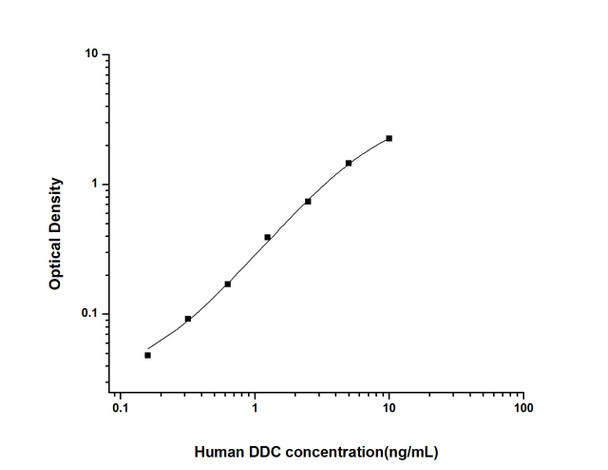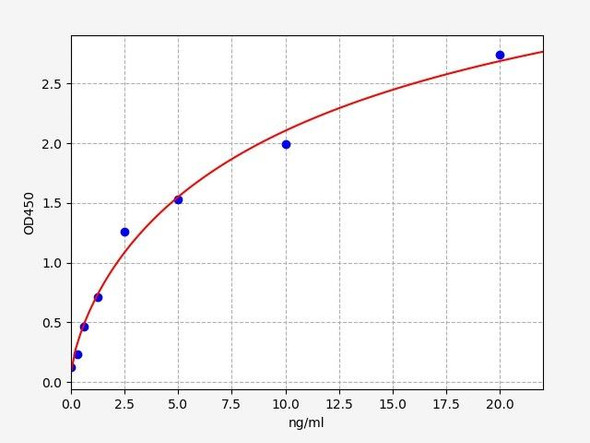Description
Human DDC (Dopamine Decarboxylase) ELISA Kit
The Human DDC (Dopamine Decarboxylase) ELISA Kit is specifically designed for the accurate measurement of DDC levels in human serum, plasma, and cell culture supernatants. This kit offers high sensitivity and specificity, ensuring precise and reliable results for a variety of research purposes.DDC is an important enzyme involved in the conversion of L-DOPA to dopamine, a crucial neurotransmitter in the central nervous system. Dysregulation of DDC activity has been linked to various neurological disorders, including Parkinson's disease and schizophrenia.
As such, measuring DDC levels can provide valuable insights into the pathogenesis of these conditions and aid in the development of targeted therapies.Overall, the Human DDC ELISA Kit is a valuable tool for researchers studying neurotransmitter metabolism and investigating potential therapeutic strategies for neurological disorders.
| Assay type: | Sandwich |
| Format: | 96T |
| Assay time: | 4.5h |
| Reactivity: | Human |
| Detection Method: | Colormetric |
| Detection Range: | 0.16-10 ng/mL |
| Sensitivity: | 0.10 ng/mL |
| Sample Volume Required Per Well: | 100µL |
| Sample Type: | Serum, plasma and other biological fluids |
| Specificity: | This kit recognizes Human DDC in samples. No significant cross-reactivity or interference between Human DDC and analogues was observed. |
This ELISA kit uses Sandwich-ELISA as the method. The micro ELISA plate provided in this kit has been pre-coated with an antibody specific to Human DDC. Standards or samples are added to the appropriate micro ELISA plate wells and combined with the specific antibody. Then a biotinylated detection antibody specific for Human DDC and Avidin-Horseradish Peroxidase (HRP) conjugate are added to each micro plate well successively and incubated. Free components are washed away. The substrate solution is added to each well. Only those wells that contain Human DDC, biotinylated detection antibody and Avidin-HRP conjugate will appear blue in color. The enzyme-substrate reaction is terminated by adding Stop Solution and the color turns yellow. The optical density (OD) is measured spectrophotometrically at a wavelength of 450 nm ± 2 nm. The OD value is proportional to the concentration of Human DDC. The concentration of Human DDC in samples can be calculated by comparing the OD of the samples to the standard curve.
| UniProt Protein Function: | DDC: Catalyzes the decarboxylation of L-3,4- dihydroxyphenylalanine (DOPA) to dopamine, L-5-hydroxytryptophan to serotonin and L-tryptophan to tryptamine. Homodimer. Belongs to the group II decarboxylase family. |
| UniProt Protein Details: | Protein type:Amino Acid Metabolism - tryptophan; EC 4. 1. 1. 28; Amino Acid Metabolism - histidine; Amino Acid Metabolism - tyrosine; Nuclear receptor co-regulator; Amino Acid Metabolism - phenylalanine; Lyase Chromosomal Location of Human Ortholog: 7p12. 2 Cellular Component: synaptic vesicle; cell soma; axon; cytosol Molecular Function:aromatic-L-amino-acid decarboxylase activity; protein domain specific binding; amino acid binding; protein binding; enzyme binding; pyridoxal phosphate binding Biological Process: circadian rhythm; amino acid metabolic process; catecholamine biosynthetic process; indolalkylamine biosynthetic process; multicellular organismal aging; isoquinoline alkaloid metabolic process; dopamine biosynthetic process; serotonin biosynthetic process; phytoalexin metabolic process; synaptic vesicle amine transport; response to pyrethroid Disease: Aromatic L-amino Acid Decarboxylase Deficiency |
| NCBI Summary: | The encoded protein catalyzes the decarboxylation of L-3,4-dihydroxyphenylalanine (DOPA) to dopamine, L-5-hydroxytryptophan to serotonin and L-tryptophan to tryptamine. Defects in this gene are the cause of aromatic L-amino-acid decarboxylase deficiency (AADCD). AADCD deficiency is an inborn error in neurotransmitter metabolism that leads to combined serotonin and catecholamine deficiency. Multiple alternatively spliced transcript variants encoding different isoforms have been identified for this gene. [provided by RefSeq, Jun 2011] |
| UniProt Code: | P20711 |
| NCBI GenInfo Identifier: | 311033369 |
| NCBI Gene ID: | 1644 |
| NCBI Accession: | P20711. 2 |
| UniProt Secondary Accession: | P20711,O88533, P14173, |
| UniProt Related Accession: | P20711 |
| Molecular Weight: | 480 |
| NCBI Full Name: | Aromatic-L-amino-acid decarboxylase |
| NCBI Synonym Full Names: | dopa decarboxylase (aromatic L-amino acid decarboxylase) |
| NCBI Official Symbol: | DDC |
| NCBI Official Synonym Symbols: | AADC |
| NCBI Protein Information: | aromatic-L-amino-acid decarboxylase |
| UniProt Protein Name: | Aromatic-L-amino-acid decarboxylase |
| UniProt Synonym Protein Names: | DOPA decarboxylase; DDC |
| Protein Family: | Aromatic-L-amino-acid decarboxylase |
| UniProt Gene Name: | DDC |
| UniProt Entry Name: | DDC_HUMAN |
As the OD values of the standard curve may vary according to the conditions of the actual assay performance (e. g. operator, pipetting technique, washing technique or temperature effects), the operator should establish a standard curve for each test. Typical standard curve and data is provided below for reference only.
| Concentration (ng/mL) | O.D | Average | Corrected |
| 10 | 2.294 2.34 | 2.317 | 2.264 |
| 5 | 1.497 1.515 | 1.506 | 1.453 |
| 2.5 | 0.806 0.776 | 0.791 | 0.738 |
| 1.25 | 0.438 0.45 | 0.444 | 0.391 |
| 0.63 | 0.226 0.22 | 0.223 | 0.17 |
| 0.32 | 0.155 0.135 | 0.145 | 0.092 |
| 0.16 | 0.095 0.107 | 0.101 | 0.048 |
| 0 | 0.05 0.056 | 0.053 | -- |
Precision
Intra-assay Precision (Precision within an assay): 3 samples with low, mid range and high level Human DDC were tested 20 times on one plate, respectively.
Inter-assay Precision (Precision between assays): 3 samples with low, mid range and high level Human DDC were tested on 3 different plates, 20 replicates in each plate.
| Intra-assay Precision | Inter-assay Precision | |||||
| Sample | 1 | 2 | 3 | 1 | 2 | 3 |
| n | 20 | 20 | 20 | 20 | 20 | 20 |
| Mean (ng/mL) | 0.54 | 1.32 | 4.53 | 0.54 | 1.44 | 4.42 |
| Standard deviation | 0.03 | 0.08 | 0.22 | 0.03 | 0.07 | 0.18 |
| C V (%) | 5.56 | 6.06 | 4.86 | 5.56 | 4.86 | 4.07 |
Recovery
The recovery of Human DDC spiked at three different levels in samples throughout the range of the assay was evaluated in various matrices.
| Sample Type | Range (%) | Average Recovery (%) |
| Serum (n=5) | 86-98 | 92 |
| EDTA plasma (n=5) | 85-98 | 91 |
| Cell culture media (n=5) | 89-102 | 95 |
Linearity
Samples were spiked with high concentrations of Human DDC and diluted with Reference Standard & Sample Diluent to produce samples with values within the range of the assay.
| Serum (n=5) | EDTA plasma (n=5) | Cell culture media (n=5) | ||
| 1:2 | Range (%) | 97-112 | 94-109 | 95-110 |
| Average (%) | 104 | 102 | 102 | |
| 1:4 | Range (%) | 91-104 | 85-97 | 84-95 |
| Average (%) | 96 | 91 | 89 | |
| 1:8 | Range (%) | 88-100 | 84-98 | 84-95 |
| Average (%) | 94 | 91 | 89 | |
| 1:16 | Range (%) | 88-102 | 83-96 | 86-96 |
| Average (%) | 94 | 90 | 91 |
An unopened kit can be stored at 4°C for 1 month. If the kit is not used within 1 month, store the items separately according to the following conditions once the kit is received.
| Item | Specifications | Storage |
| Micro ELISA Plate(Dismountable) | 8 wells ×12 strips | -20°C, 6 months |
| Reference Standard | 2 vials | |
| Concentrated Biotinylated Detection Ab (100×) | 1 vial, 120 µL | |
| Concentrated HRP Conjugate (100×) | 1 vial, 120 µL | -20°C(shading light), 6 months |
| Reference Standard & Sample Diluent | 1 vial, 20 mL | 4°C, 6 months |
| Biotinylated Detection Ab Diluent | 1 vial, 14 mL | |
| HRP Conjugate Diluent | 1 vial, 14 mL | |
| Concentrated Wash Buffer (25×) | 1 vial, 30 mL | |
| Substrate Reagent | 1 vial, 10 mL | 4°C(shading light) |
| Stop Solution | 1 vial, 10 mL | 4°C |
| Plate Sealer | 5 pieces | |
| Product Description | 1 copy | |
| Certificate of Analysis | 1 copy |
- Set standard, test sample and control (zero) wells on the pre-coated plate and record theirpositions. It is recommended to measure each standard and sample in duplicate. Note: addall solutions to the bottom of the plate wells while avoiding contact with the well walls. Ensuresolutions do not foam when adding to the wells.
- Aliquot 100 µL of standard solutions into the standard wells.
- Add 100 µL of Sample / Standard dilution buffer into the control (zero) well.
- Add 100 µL of properly diluted sample (serum, plasma, tissue homogenates and otherbiological fluids) into test sample wells.
- Cover the plate with the sealer provided in the kit and incubate for 90 min at 37 °C.
- Aspirate the liquid from each well, do not wash. Immediately add 100 µL of BiotinylatedDetection Ab working solution to each well. Cover the plate with a plate seal and gently mix. Incubate for 1 hour at 37 °C.
- Aspirate or decant the solution from the plate and add 350 µL of wash buffer to each welland incubate for 1-2 minutes at room temperature. Aspirate the solution from each well andclap the plate on absorbent filter paper to dry. Repeat this process 3 times. Note: a microplatewasher can be used in this step and other wash steps.
- Add 100 µL of HRP Conjugate working solution to each well. Cover with a plate seal andincubate for 30 min at 37 °C.
- Aspirate or decant the solution from each well. Repeat the wash process for five times asconducted in step 7.
- Add 90 µL of Substrate Reagent to each well. Cover with a new plate seal and incubate forapproximately 15 min at 37 °C. Protect the plate from light. Note: the reaction time can beshortened or extended according to the actual color change, but not by more than 30min.
- Add 50 µL of Stop Solution to each well. Note: Adding the stop solution should be done inthe same order as the substrate solution.
- Determine the optical density (OD value) of each well immediately with a microplate readerset at 450 nm.








